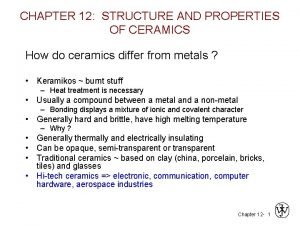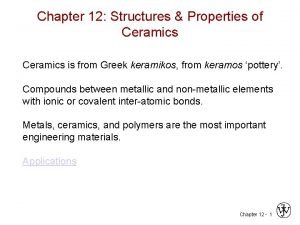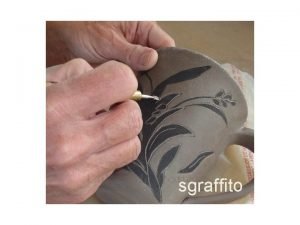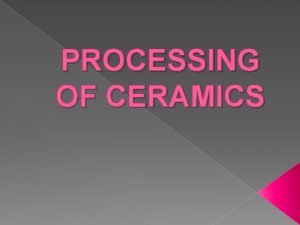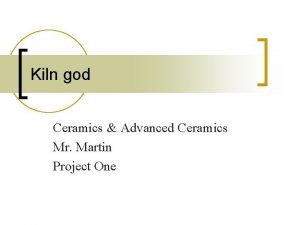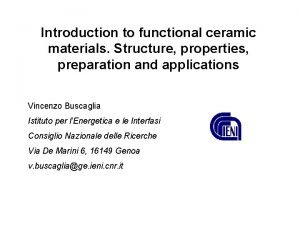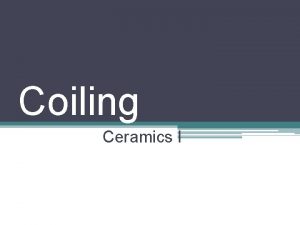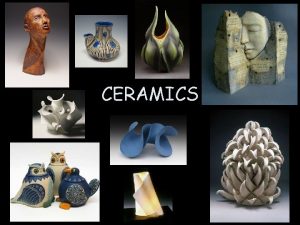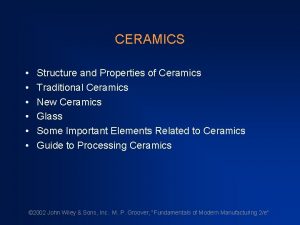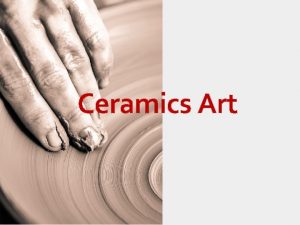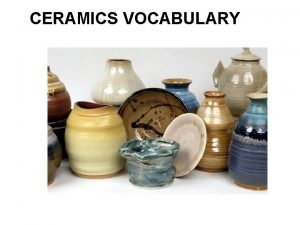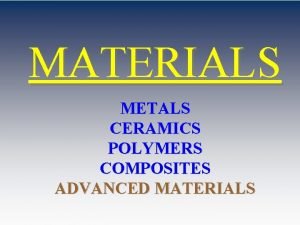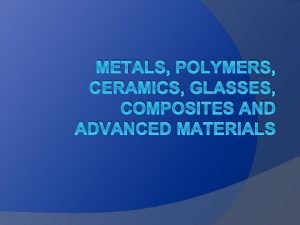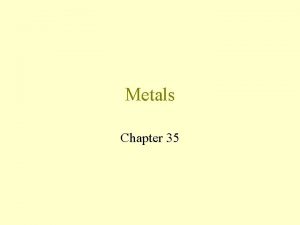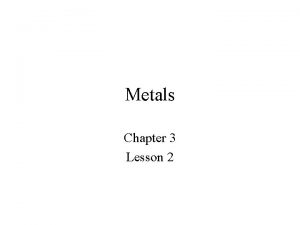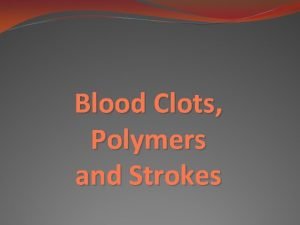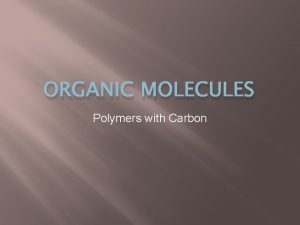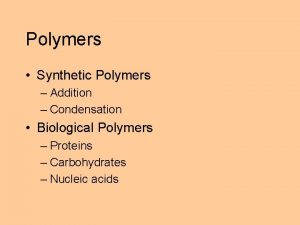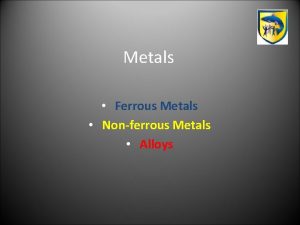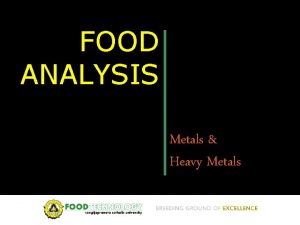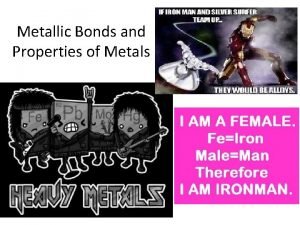Chapter 4 Structures of Polymers polymers ceramics metals

















- Slides: 17

Chapter 4 Structures of Polymers

polymers ceramics metals Structures of Solid Materials general Crystalline materials -Materials which have crystal structure. -dense, ordered packing. -atoms pack in periodic, 3 D arrays @ long range atomic order. -tend to have higher (max. ) bond energies. Linear, branched, cross-linked, network structures (as molecular chains) Others: silicate, glass, carbon ceramics. AX, AX 2 & ABX 3 type crystal structures, -Occurs for: normal solidification conditions. SC, BCC, FCC, HCP crystal structures Energy -Typical of: metals, many ceramics & certain polymers. typical neighbor bond length r crystalline Si. O 2 typical neighbor bond energy crystal structure (refer to atomic arrangement in crystalline materials) Noncrystalline materials -Materials which have amorphous structure. Energy typical neighbor bond length -non dense, random packing. -atoms have no periodic arrays @ short range order. -tend to have lower (min. ) bond energies. -Occurs for: complex structures @ rapid cooling. -Typical of: polymers, some ceramics & metals. noncrystalline Si. O 2 typical neighbor bond energy amorphous structure (refer to atomic arrangement in noncrystalline materials) r

Characteristics of polymer molecules (chain, twisting, entanglement, etc) Structure (as polymer molecular chains) - 2 classifications: • Thermoplastic polymers. • Thermosetting polymers. Stereo isomers Geometrical isomers cis Atactic - Most polymeric materials are… • hydrocarbons (made up of H & C) – organic materials. • composed of very large molecular chains (in 2 D array) with organics group (methyl, phenyl) @ side group of various atoms (O, Cl, etc). Isomeric states Syndiotactic - All polymer are made from organic materials. • natural polymers – plants & animals (organic materials), such as: wood, rubber, cotton, wool, leather, silk etc. • synthetic polymers – R&D from organic materials, such as: polyethylene, polypropylene, polystyrene, Kevlar, nylon etc. Linear In general Network Shape (molecular weight) Branched Size (repeat unit composition) Cross-linked Chemistry Isotactic polymers Linear, branched, cross-linked, network structures (as molecular chains) ceramics Others: silicate, glass, carbon ceramics. AX, AX 2 & ABX 3 type crystal structures, SC, BCC, FCC, HCP crystal structures metals Structures of Solid Materials trans

Metals ceramics Polymers Structures of Solid Materials repeat unit H H H C C C H H H H CH 3 H Smaller structural entities that are repeated along the molecular chain. Intramolecules Covalent bond (strong) Intermolecules Hydrogen & van der Waals bonds (weak) CH 3 repeat unit Repeat units: - polymer is defined as many repeat unit (in terms of molecular chains). • these macromolecules are composed of repeat units. - 2 types of bond exist: • intramolecular bonds: covalent (between C – C). • intermolecular bonds: hydrogen & van der Waals (between C – H @ C – other atoms (O, Cl etc)). - ex: ethane, C 2 H 6 CH 3 H Polypropylene (PP) Polyethylene (PE) Polymer molecules (composition & structure) Chemistry of polymer molecules repeat unit H H H C C C H Cl Poly(vinyl chloride) (PVC) Adapted from Fig. 4. 2, Callister & Rethwisch 3 e. General terms C 2 H 6 composition (chemical formula) structure

Other hydrocarbons @ organic groups: Structure of phenyl group Methyl, CH 3 Ethyl, C 2 H 5 free radical, R from organic groups Phenyl, C 6 H 5 Metals ceramics Polymers Structures of Solid Materials Alcohols (methyl alcohol), CH 3 OH @ R – OH Ethers (dimethyl ether), C 2 H 6 OH @ R – OH – R Acids (acetic acid), CH 3 O 2 H Aldehydes (formaldehyde) Aromatic hydrocarbons (phenol) Chemistry of polymer molecules Polymer molecules (composition & structure) -composed of hydrocarbons molecules. • saturated & unsaturated hydrocarbons. Saturated hydrocarbons - also known as paraffin molecules/compounds. - each carbon singly bonded to 4 other atoms. ex: ethane, C 2 H 6 Unsaturated hydrocarbons - double & triple bonds between 2 carbon atoms. - unstable & can form new bonds. ex: ethylene or ethene, C 2 H 4 double bond - others: methane, CH 4, propane, C 3 H 8, butane, C 4 H 10, pentane, C 5 H 10 & hexane, C 6 H 14 ex: acetylene or ethyne, C 2 H 2 triple bond

Metals ceramics Polymers Structures of Solid Materials Isomerism - hydrocarbon molecules (compounds) with same composition (chemical formula) can have quite different structures (atomic arrangement). ex: C 8 H 18 Octane (normal) 2, 4 -dimethylhexane Polymer molecules Chemistry of polymer molecules Polymerization - reaction between R (catalyst species/free radical) & monomer (from unsaturated hydrocarbon) to form solid polymer materials. Monomer: Small molecule from which polymer is synthesized. 2 steps of polymerization:

Metals ceramics Polymers Structures of Solid Materials Chemistry of polymer molecules Polymer molecules A listing of 10 common polymeric materials Polymeric materials Structure repeat unit

Metals ceramics Polymers Structures of Solid Materials Chemistry of polymer molecules Polymer molecules A listing of 10 common polymeric materials Polymeric materials Structure repeat unit

Molecular size - not all chains in a polymer are of the same length. i. e. , there is a distribution of molecular weights. Low M Metals ceramics Polymers Structures of Solid Materials short molecule chains high M - molecular weight, M: Mass of a mole of chains. Size of polymer molecules Molecular weight distribution Mi = mean (middle) molecular weight of size range i xi = number fraction of chains in size range i wi = weight fraction of chains in size range i long molecule chains

Metals ceramics Polymers Structures of Solid Materials Student Molecular size mass (lb) Molecule weight calculation ex: average mass of a class What is the average weight of the students in this class: a) Based on the number fraction of students in each mass range? b) Based on the weight fraction of students in each mass range? answer: The first step is to sort the students into weight ranges. Using 40 lb ranges gives the following table: Weight 1 104 2 116 3 140 4 143 5 180 6 182 7 191 8 220 9 225 10 380 Size of polymer molecules Calculate the number and weight fraction of students in each weight range as follows: total number total weight

chain Metals ceramics Polymers Structures of Solid Materials Shape of polymer molecules Molecular shape Twisting - also known as conformation. - chain bending and twisting are possible by rotation of carbon atoms around their chain bonds. note: not necessary to break chain bonds to alter molecular shape. Entanglement

(1) Linear structures - polymers are synthesized in which… • repeat units are joined together end to end in single chains. - flexible & spaghetti like. - common polymers: • Polyethylene • Poly(vinyl chloride) • Polystyrene • Poly(methyl methacrylate) • Nylon • Fluorocarbons Metals ceramics Polymers Structures of Solid Materials Structure of polymer molecules Molecular chains structures (3) Cross-linked structures - shows the structure of the molecular chains. - all structures contain van der Waals & hydrogen bonding between the chains. - polymers are synthesized in which… • adjacent linear chains are joined one to another at various positions by covalent bonds. - accomplished by additive atoms that are covalently bonded to the chains. - common polymers: • rubber elastic materials. secondary bonding Linear Branched Cross-Linked Network (2) Branched structures - polymers are synthesized in which… • side-branch chains are connected to the main chains. - the branches may… • result from side reactions that occur during synthesis. • reduced the packing efficiency & lowered the polymer density. - common polymers: • high-density polyethylene (HDPE) • low-density polyethylene (LDPE) (4) Network structures - polymers are synthesized in which… • multifunctional monomers forming 3 @ more active covalent bonds make 3 D networks. - polymer that is highly cross-linked may also be classified as a network polymer. - these polymers have distinctive mechanical & thermal properties. - common polymers: • epoxies • polyurethanes • phenol-formaldehyde

Stereo isomers - Stereoisomers are mirror images – can’t superimpose without breaking a bond. - ex: B - Tacticity – stereoregularity or spatial arrangement of R units along chain. - It can be isotactic, syndiotactic & atactic. Isotactic configuration Molecular chains structures isomeric states Structure of polymer molecules A A C Metals ceramics Polymers Structures of Solid Materials – - shows the molecular configurations for polymers. - to change configurations, it must break bonds. - all R groups on same side of chain. Syndiotactic configuration - R groups alternate sides. Geometrical isomers - either cis @ trans isomerism. cis -H atom and CH 3 group on same side of chain. ex: cis-isoprene trans - H atom and CH 3 group on opposite sides of chain. ex: trans-isoprene Atactic configuration - R groups randomly positioned. E C E D D mirror plane B

Metals ceramics Polymers Structures of Solid Materials Thermoplastic polymers - soften when heated (eventually liquefy) & harden when cooled. • processes that are reversible & repeated. - structures: most linear polymers & some branched polymers with flexible chains. - properties: soft & less dimensional stability. - common polymers: • polyethylene. • poly(vinyl chloride). • polystyrene. • poly(ethylene terephthalate). Classification of polymeric materials Polymers classification Thermosetting polymers - permanently hard during their formation & do not soften when heated. • processes that are not reversible & repeated. - structures: most network polymers & cross-linked polymers. - properties: hard, strong & high dimensional stability. - common polymers: • epoxies. • phenolics. • polyester resins. Copolymers - 2 @ more monomers polymerized together. - 4 types: 1. random – A and B randomly positioned along chain. 2. alternating – A and B alternate in polymer chain. 3. block – large blocks of A units alternate with large blocks of B units. 4. graft – chains of B units grafted onto A backbone. A– B– random alternating block graft

Metals ceramics Polymers Structures of Solid Materials Polymer crystallinity - ordered atomic arrangements involving molecular chains. - crystal structures in terms of unit cells. ex: thin platelets with chain folds at faces. polyethylene unit cell. 10 nm Adapted from Fig. 4. 12, Callister & Rethwisch 3 e. chain folded structure Polymer crystallinity polyethylene unit cell - polymers rarely 100% crystalline • difficult for all regions of all chains region to become aligned. - degree of crystallinity expressed as % crystallinity. • some physical properties depend on % crystallinity. • heat treating causes crystalline regions to grow & % crystallinity to increase. amorphous region Adapted from Fig. 14. 11, Callister 6 e. (Fig. 14. 11 is from H. W. Hayden, W. G. Moffatt, and J. Wulff, The Structure and Properties of Materials , Vol. III, Mechanical Behavior, John Wiley and Sons, Inc. , 1965. )

Polymer single crystal - single crystals – only for slow and carefully controlled growth rates. - electron micrograph – multilayered single crystals (chain-folded layers) of polyethylene. Metals ceramics Polymers Structures of Solid Materials Polymer semi crystal Polymer crystallinity - some semicrystalline polymers form spherulite structures. - alternating chain-folder crystallites and amorphous regions. - spherulite structure for relatively rapid growth rates. Cross-polarized light used - a maltese cross appears in each spherulite Photomicrograph – Spherulites in polyethylene

End of Chapter 4
 Structure and properties of ceramics
Structure and properties of ceramics Rcation/ranion
Rcation/ranion Non metals periodic table
Non metals periodic table Ferrous vs non ferrous
Ferrous vs non ferrous Properties of metals nonmetals and metalloids
Properties of metals nonmetals and metalloids Grade 6 natural science matter and materials
Grade 6 natural science matter and materials Grade 9 natural science term 2 notes
Grade 9 natural science term 2 notes Reactivity in periodic table
Reactivity in periodic table Ionic compounds
Ionic compounds Chapter 7 chapter assessment ionic compounds and metals
Chapter 7 chapter assessment ionic compounds and metals How are the whale flipper and the human arm different
How are the whale flipper and the human arm different Sgraffito pottery
Sgraffito pottery Processing of ceramics
Processing of ceramics Kiln god ceramics
Kiln god ceramics Functional ceramics application
Functional ceramics application Needle tool ceramics definition
Needle tool ceramics definition Charlotte manser ceramics
Charlotte manser ceramics Coiling definition ceramics
Coiling definition ceramics
